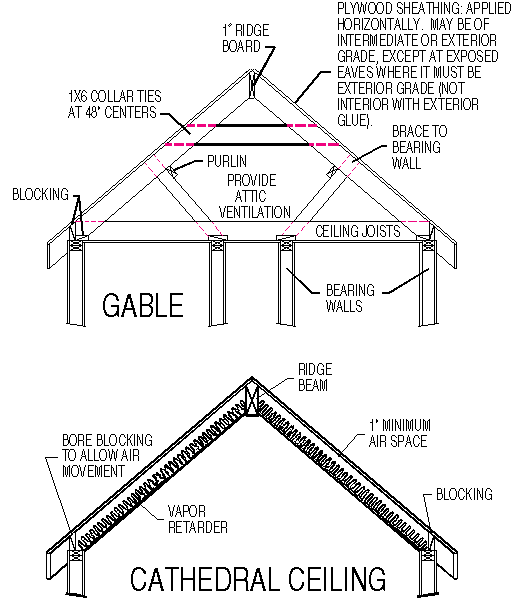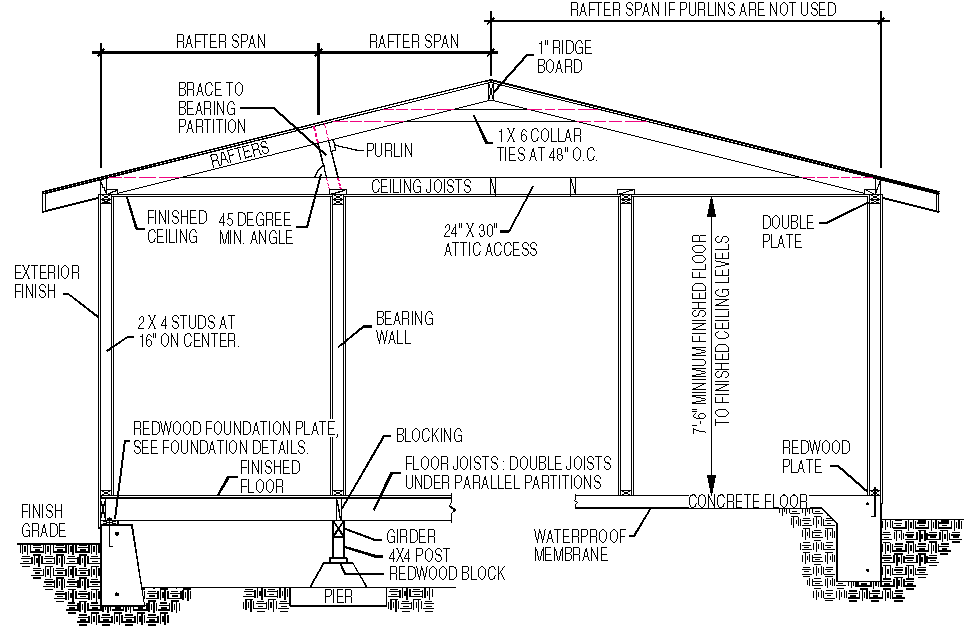Excerpts from the 1994 Uniform Building Code TM, copyright ©
1994, are included in this guide with the permission of the publisher, the
International Conference of Building Officials.
|
|
|
|
Span tables are included in this booklet for conventional framing methods based on uniform loads.
Sec. 2326.12. Roof and Ceiling Framing.
Sec. 2326.12.1. General. The framing details required in this section apply to roofs having a minimum slope of 3 units vertical in 12 units horizontal (25% slope) or greater.
Sec. 2326.12.2. Spans. Allowable spans for ceiling joists shall be in accordance with Tables 23-I-V-J-3 and 23-I-V-J-4. Allowable spans for rafters shall be in accordance with Tables 23-I-V-R-1 through 23-I-V-R-12, where applicable.
Sec. 2326.12.3. Framing. Rafters shall be framed directly opposite each other at the ridge. There shall be a ridge board at least 1-inch (25 mm) nominal thickness at all ridges and not less in depth than the cut end of the rafter. At all valleys and hips there shall be a single valley or hip rafter not less than 2-inch (51 mm) nominal thickness and not less in depth than the cut end of the rafter.
Sec. 2326.12.4. Notches and holes. Notching at the ends of rafters or ceiling joists shall not exceed one sixth the depth and shall not be located in the middle one third of the span, except that a notch not exceeding one third of the depth is permitted in the top of the rafter or ceiling joist not further from the face of the support than the depth of the member.
Holes bored in rafters or ceiling joists shall not be within 2 inches (51 mm) of the top and bottom and their diameter shall not exceed one third the depth of the member.
Sec. 2326.12.5. Framing around openings. Trimmer and header rafters shall be doubled or of lumber of equivalent cross-section, when the span of the header exceeds 4 feet (1219 mm). The ends of header rafters more than 6 feet (1829 mm) long shall be supported by framing anchors or rafter hangers unless bearing on a beam, partition or wall.
Sec. 2326.12.6. Rafter ties. Rafters shall be nailed to adjacent ceiling joists to form a continuous tie between exterior walls when such joists are parallel to the rafters. Where not parallel, rafters shall be tied to 1-inch by 4-inch (25 mm by 102 mm) (nominal) minimum-size crossties. Rafter ties shall be spaced not more than 4 feet (1219 mm) on center.
Sec. 2326.12.7. Purlins. Purlins to support roof loads may be installed to reduce the span of the rafters within allowable limits and shall be supported by struts to bearing walls. The maximum span of 2-inch by 4-inch (51 mm by 102 mm) purlins shall be 4 feet (1219 mm). The maximum span of 2-inch by 6-inch (51 mm by 152 mm) purlins shall be 6 feet (1829 mm) but in no case shall the purlin be smaller than the supported rafter. Struts shall not be smaller than 2-inch by 4-inch (51 mm by 102 mm) members. The unbraced length of struts shall not exceed 8 feet (2438 mm) and the minimum slope of the struts shall not be less than 45 degrees from the horizontal.
Sec. 2326.12.8. Blocking. Roof rafters and ceiling joists shall be supported laterally to prevent rotations and lateral displacement when required by Section 2306.7. Roof trusses shall be supported laterally at points of bearing by solid blocking to prevent rotation and lateral displacement.
Sec. 2326.12.9. Roof sheathing. Roof sheathing shall be in accordance with Table 23-I-S-1 for wood structural panels, Table 23-I-R-1 for lumber or Table 23-I-R-2 for particleboard.
Joints in lumber sheathing shall occur over supports unless approved end-matched lumber is used, in which case each piece shall bear on at least two supports.
Wood structural panels used for roof sheathing shall be bonded by intermediate or exterior glue. Wood structural panel roof sheathing exposed on the underside shall be bonded with exterior glue.
Sec. 2326.12.10. Roof planking. Planking shall be designed in accordance with the general provisions of this code.
In lieu of such design, 2-inch (51 mm) tongue and groove planking may be used in accordance with Table 23-I-U. Joints in such planking may be randomly spaced, provided the system is applied to not less than three continuous spans, planks are center-matched and end-matched or spliced, each plank bears on at least one support, and joints are separated by at least 24 inches (610 mm) in adjacent pieces.
Span tables are included in this booklet for conventional framing methods based on uniform loads. The tables follow this section. Strongbacks are not given any credit when evaluating maximum span. Ceiling joists cannot be used to brace roof framing. Ceiling joists 2 x 6 and larger should be solidly blocked at ends.
Enclosed attics and enclosed rafter spaces formed where ceilings are applied to the under side of roof rafters shall have cross ventilation for each separate space per UBC Sec. 1505.3.
Sec. 1505.1. Access. An attic access opening shall be provided in attics with a vertical height of 30 inches or more. The opening shall be not less than 22 inches by 30 inches. The opening shall be located in a corridor, hallways or other redily accessible location.
Roof And Ceiling Framing Diagram

